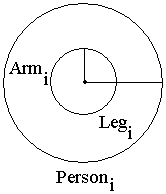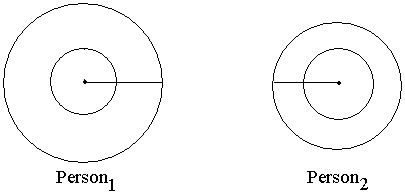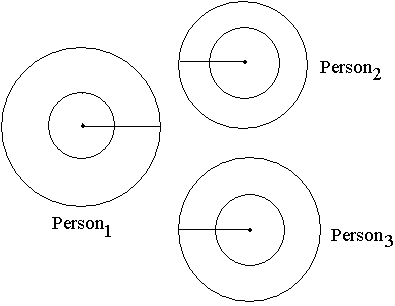Mathematical Combat Distance
1/27/07
Intuitively, one understands that danger is inversely proportional to the distance from a threat. In the martial arts, this concept of "combative distance" is crucial.
This informal article will outline one way of looking at combat distance. I've personally found it useful, and hope others can.
Let's represent each Personi by a circle of radius Legi and concentric circle of radius Armi. The center of the circle is the center of a person; their center of gravity, core, tanden, tantien, etc.

Each radius is the reach of the arm and leg respectively, and the extent of each reach is marked by the edge of the circle. Note that these distances can be measured for any person. Simply stand stationary, extend a limb, and have someone measure the distance the limb extends, using a measuring tape.
What happens when two people, who are a distance, d, apart, approach each other? The outcome (keep in mind our assumptions, listed at the end of the article), hinges on two factors
- How does Leg1 compare to Leg2?
- How does Arm1 compare to Arm2?

If these people approach (cross your eyes to make them approach), Person1 is able to touch Person2's center first or able to "cover" a larger fraction of Person2. How can we mathematically express this?
Note that when Person1 is able to do this, more of Person2 is overlapped by Person1 than vice versa. This overlap, expressed mathematically as a measure of area, is
Therefore, the percentage overlap of Person2 is the overlap divided by Person2's area, or
Let's label this number by LegDanger2, and note that if LegDangeri > LegDangerj, then Personi is in more trouble than Personj from leg attacks.
Note, however, that if Person1's leg attack fails, then Person2's arm attack is able to get to Person1's center first, barely. This is why one must take into account both leg and arm attacks. The above formula for A is calculated using the Arm radii, and we get ArmDanger1 and ArmDanger2 respectively.
Therefore, Person1's total danger is
Written out in full, this is
For a given time in an encounter, one can compare Danger1 and Danger2. If Danger1 > Danger2, then Person1 is, theoretically, in trouble.
The discussion has been held to open-hand combat. Most weapons could be included in the Arm radius. However, a weapon like a gun would have a huge radius, hundreds of feet, and its circle would easily overlap any non-weapon carrying person.
What happens with multiple opponents? Say Person1 is being attacked by Person2 and Person3

To assess danger, we'd compare Danger1 to Danger2 + Danger3.
In this article, there are several assumptions that are needed so we can talk about such a simple model
- model is 2-dimensional. One could consider doing the same analysis using spheres and volumes
- each person can attack and defend 360 degrees
- beside arm and leg reach, each person is equal in all other aspects
- attacking or controlling the opponent's center is the goal, and is most devastating
Please anonymously VOTE on the content you have just read:
Like:Dislike: